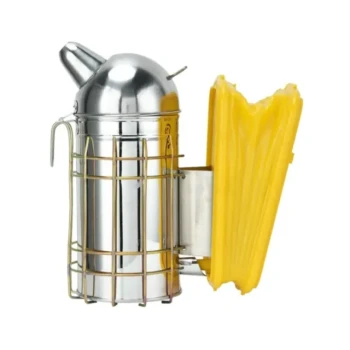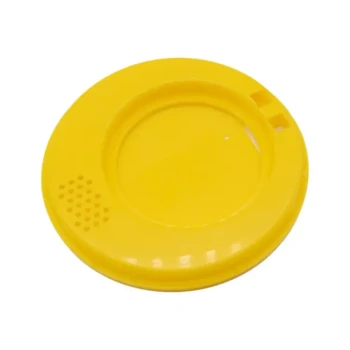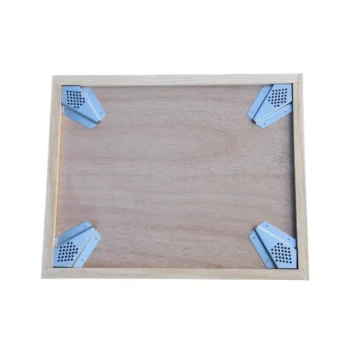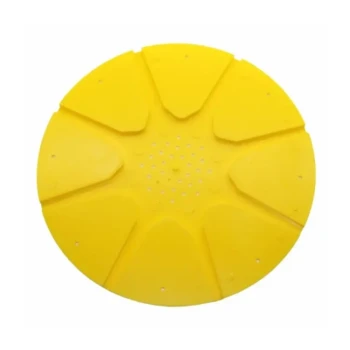Instrumental insemination is a highly controlled laboratory procedure that replaces a honey bee queen's natural mating flights. It involves manually collecting semen from specific drones and then precisely injecting that semen into the oviducts of an anesthetized virgin queen using specialized microscopic equipment.
While the process itself is mechanical, its true purpose is genetic. Instrumental insemination is the primary tool for advanced bee breeding, allowing for the precise selection and propagation of desirable traits like disease resistance, gentleness, and productivity.

The Core Process: A Step-by-Step Overview
The procedure is meticulous and requires a steady hand, a deep understanding of bee anatomy, and significant practice to master. It transforms mating from a random event in nature into a deliberate, repeatable scientific process.
Step 1: Selecting the Drones
Before any procedure begins, drone (male) bees are selected from colonies that exhibit the specific genetic traits the breeder wishes to propagate. This is the foundation of the entire process.
Step 2: Semen Collection
Mature, sexually developed drones are stimulated to ejaculate. The breeder then uses a specialized glass or plastic capillary tube attached to a syringe to collect the minuscule amount of semen, carefully avoiding mucus contamination.
This process is often repeated with dozens or even hundreds of drones to collect enough semen for a single queen or to create a homogenized mixture for multiple queens.
Step 3: Preparing the Queen
A virgin queen bee is briefly anesthetized, typically using carbon dioxide (CO2). This immobilizes her and also stimulates her ovaries, preparing her to begin laying eggs after the procedure.
Step 4: The Insemination Procedure
The anesthetized queen is secured in a specialized holding device under a microscope. Using precise micromanipulators, the insemination technician carefully inserts the capillary tip into the queen's median oviduct, bypassing the sting chamber, and injects the collected semen.
The amount of semen is carefully measured to ensure the queen is "well-mated," giving her enough sperm to last her productive lifetime of 2-3 years.
Step 5: Post-Procedure Success
After insemination, the queen recovers and is introduced into a small nucleus colony. Success is measured by how quickly she begins oviposition (laying fertilized eggs). Modern techniques achieve success rates and timelines comparable to naturally mated queens.
Why It's Used: The Strategic Advantages of Controlled Mating
Instrumental insemination is not used for honey production hives; it is a tool exclusively for breeding and research. The control it provides is unmatched by any other method.
Unlocking Specific Genetic Crosses
Breeders can create crosses between subspecies of bees from different continents or make pairings that would never occur naturally due to timing or geography.
Amplifying Valuable Traits
Semen from a single, highly valuable drone can be used to inseminate multiple queens, rapidly amplifying a desirable trait throughout a breeding population.
Creating Genetic Consistency
For large-scale queen producers, semen from hundreds of drones can be homogenized (mixed). This ensures that every queen in a batch is inseminated with the same genetic mix, leading to highly consistent and predictable colony behavior for their customers.
Enabling Advanced Breeding Systems
The technique allows for complex breeding designs, such as closed population breeding, which simplifies the maintenance and improvement of specific genetic stock over many generations.
Understanding the Trade-offs and Requirements
While powerful, instrumental insemination is not a simple solution and comes with significant barriers to entry.
The Need for Specialized Equipment
The process requires a stereomicroscope, an insemination device with micromanipulators, CO2 delivery systems, and various custom tools. This represents a significant financial investment.
A Steep Learning Curve
The references rightly state that the technique requires extensive practice to master. It is a delicate motor skill that combines biology and mechanics, and failure rates for beginners are high.
Prerequisite of Breeding Knowledge
Simply knowing how to perform the procedure is not enough. To be effective, the user must have a solid foundation in bee genetics and breeding principles to know which bees to cross and why. The tool is only as good as the breeding strategy behind it.
Making the Right Choice for Your Goal
Instrumental insemination is a specialized tool for a specific job. Its value depends entirely on your objectives as a beekeeper.
- If your primary focus is a research or formal breeding program: Instrumental insemination is an essential tool for controlling genetic variables and propagating specific, desirable traits.
- If your primary focus is creating a new hybrid or specific cross: This technique is the only reliable way to guarantee the parentage and genetic makeup of your new queen stock.
- If your primary focus is simply maintaining healthy, productive backyard hives: Relying on naturally mated queens from reputable suppliers is far more practical, cost-effective, and efficient.
Ultimately, instrumental insemination empowers beekeepers to transition from being hive managers to true genetic architects.
Summary Table:
| Step | Description | Key Takeaway |
|---|---|---|
| Drone Selection | Choose drones with desirable genetic traits (e.g., disease resistance). | Foundation for genetic control. |
| Semen Collection | Collect semen from drones using capillary tubes. | Requires precision to avoid contamination. |
| Queen Preparation | Anesthetize virgin queen with CO₂. | Immobilizes queen and stimulates ovaries. |
| Insemination | Inject semen into queen's oviduct using micromanipulators. | Ensures measured sperm for queen's lifetime. |
| Post-Procedure | Monitor queen for oviposition in nucleus colony. | Success rates match natural mating. |
Ready to Elevate Your Beekeeping Program?
For commercial apiaries and distributors, mastering genetic control is key to producing resilient, high-yield colonies. HONESTBEE supplies the specialized equipment—from microscopes to insemination tools—needed for advanced breeding. Whether you're launching a breeding program or scaling operations, our wholesale-focused solutions ensure precision and consistency.
Contact us today to discuss how our supplies can support your genetic breeding goals!
Visual Guide
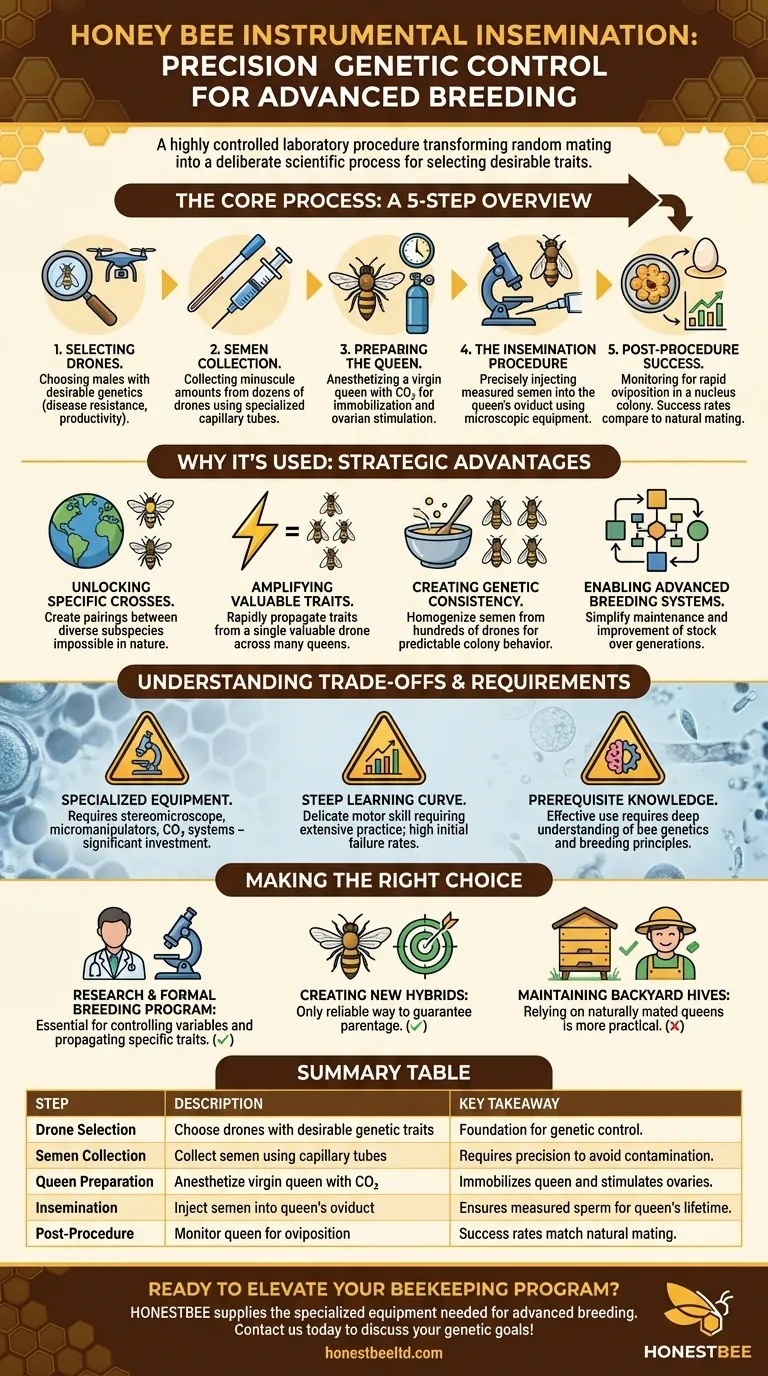
Related Products
- Queen Bee Artificial Insemination Instrument Equipment for Instrumental Insemination
- Plastic Chinese Queen Grafting Tool for Bee Queen Rearing
- Wooden Queen Bee Excluder for Beekeeping
- Plastic Long Marker Device for Catching and Marking Bees Queen Bee Marking Tube and Cage
- Professional Spring-Action Queen Catcher Clip
People Also Ask
- What are the methods for controlling honey bee mating? Mastering Genetic Selection for Your Apiary
- What is the basic process of artificial insemination in honey bees? A Guide to Controlled Breeding for Superior Genetics
- How is success of honey bee artificial insemination evaluated? From Oviposition to Long-Term Queen Quality
- What is the standard semen dose for AI of a honey bee queen? Master the 8-10 µl Precision for Longevity
- What is instrumental insemination's role in bee breeding? Master Genetic Control for Superior Honey Bees










